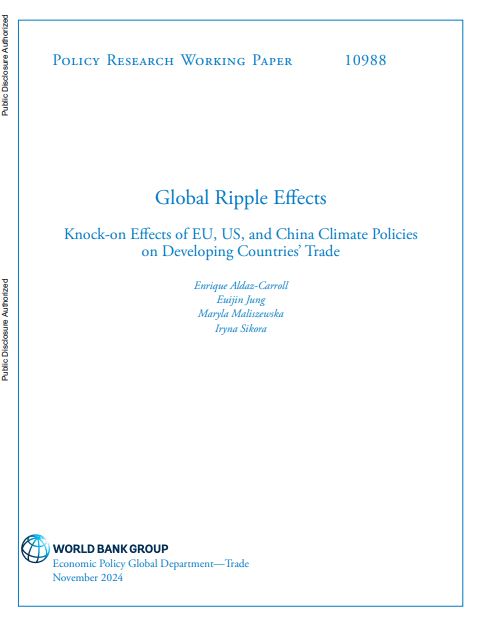
□ 세계 경제의 세 주요 주체인 미국, 유럽연합(EU), 중국은 자국의 탄소 배출을 줄이기 위한 기후 완화 정책을 설계하고 있으며, 이러한 정책은 개발도상국의 무역 구조, 가격, 기술 접근성에 중대한 변화를 초래할 가능성이 있음. 본 보고서는 이러한 변화에 대해 개발도상국이 얼마나 노출되어 있는지를 분석함
□ 전반적으로 이러한 정책은 화석연료, 에너지 집약적 제조업, 환경 파괴와 연관된 농산물 수출에 대한 수요를 감소시키는 반면, 핵심 광물, 전기차 및 그 부품, 재생에너지 기술 및 부품 분야에서 수출 기회를 창출할 것으로 예상됨. 영향을 받는 수출 부문 및 전체 경제의 노출도는 각국의 수출 시장(미국, EU, 중국) 지향성 및 해당 품목이 경제에서 차지하는 비중에 따라 달라짐
□ 또한 이러한 기후 정책은 석유 가격을 낮추고 핵심 광물 가격을 높이며, 녹색 기술의 비용을 낮추고 녹색 분야에 대한 해외 투자를 증가시킬 가능성이 있음. 본 보고서는 개발도상국이 기후 정책으로 인한 부정적 경쟁력 저하를 줄이고, 보다 빠른 녹색 전환과 경제 발전의 기회를 최대한 활용할 수 있도록 개발도상국뿐만 아니라 EU, 미국, 중국 및 국제사회에 대한 정책적 권고를 제시함
목차
Title page 1
Contents 1
Abstract 2
1. Introduction 4
2. Climate change mitigation policies in the EU, US, and China and their impacts on trade 5
2.1. EU, US, and China climate policies: Carbon pricing, green subsidies, and regulations 5
2.2. Main elements of EU, US, and China climate policies with impacts on developing countries 7
3. Implications of trade-related climate policies for developing countries 13
3.1. Impacts on traditional sectors 15
3.2. Impacts through green transition sectors 20
3.3. Impacts through prices 25
3.4. Impacts through access to technology 26
4. Conclusion and policy recommendations 27
4.1. Recommendations for developing countries 27
4.2. Recommendations for the EU, US, and China 29
4.3. Support by the international community 29
4.4. Further research 30
References 32
Tables 11
Table 1. List of critical minerals identified as strategic for both the EU and the US economies 11
Table 2. EU mineral demand forecasts in a high demand scenario 21
Table 3. Top countries in strategic critical minerals reserves, (% of global reserve) 21
Figures 12
Figure 1. Chinese BRI engagement in metals and mining sector 12
Figure 2. Main impacts and affected agents of the EU, US, and China climate policies 14
Figure 3. Top 10 developing countries according to economic exposure of fossil fuels to the EU, US, and China policies 16
Figure 4. Developing countries with largest GVC exposure to the EU: Petroleum, Chemical and Non-Metallic Mineral Products (percent of domestic products output) 16
Figure 5. Top 5 and bottom 5 countries in Aggregate Relative CBAM Exposure Index 18
Figure 6. GVC exposure to the EU: Metal products 19
Figure 7. Top 10 developing countries according to their economic exposure to EUDR 19
Figure 8. Global value chain exposure to the EU: Textiles 20
Figure 9. Top 10 developing countries according to economic exposure to impacts of EU, US, and China policies on exports of critical minerals 20
Figure 10. Top 10 developing countries according to economic exposure to impacts of the EU, US, and China policies on EV components exports 23
Figure 11. Top 10 developing countries according to economic exposure to impacts of EU, US, and China policies on battery exports 24
Figure 12. Top 10 developing countries according to economic exposure to impacts of EU, US, and China policies on EV exports 25
Figure 13. Top 10 developing countries according to economic exposure to impacts of EU, US, and China policies on exports of renewable technology and components... 25
Figure 14. Top 10 developing countries largest importers of environmental goods from China 27


